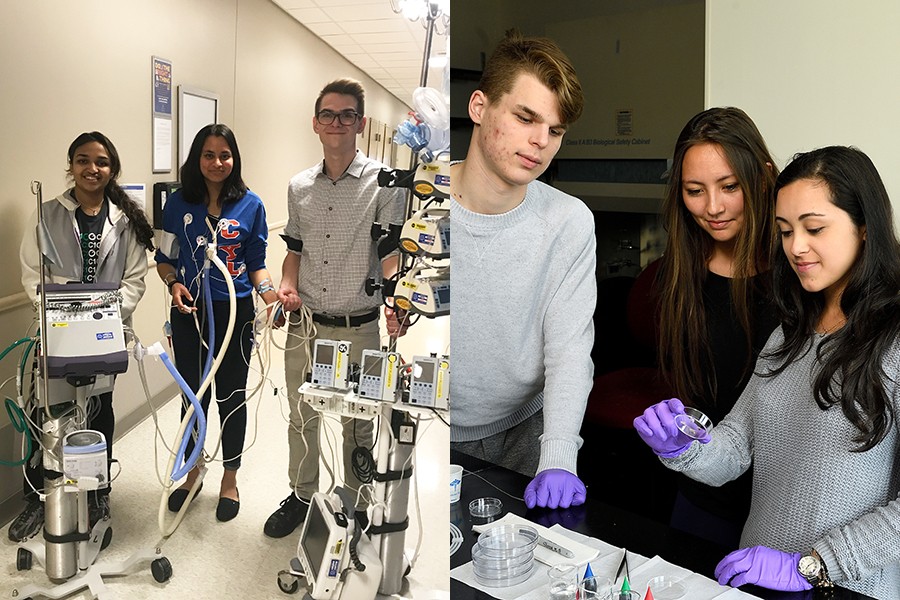A blood-clotting "super gel." A mobile app for heart attack recovery. A pizza-delivering drone. A souped-up walker for pediatric ICU patients.
Johns Hopkins engineering students have plenty to show off on Tuesday at the annual Design Day.
Design Day is a Johns Hopkins tradition that began in the Department of Mechanical Engineering 34 years ago and has now grown to include all nine departments in the Whiting School of Engineering. Throughout the day, students will showcase more than 100 design projects that they've worked on during their studies. They will present their demos and ideas to an estimated 700 guests, including alumni, clinicians, and industry partners.
"During the course of their studies, our students receive a deep foundation in basic science, mathematics, and engineering disciplines," says Ed Schlesinger, dean of the Whiting School. "But most importantly, design projects are an opportunity for students to move beyond theoretical knowledge and to ensure that they graduate as 'engineers.' Students are given the opportunity to work with faculty members, clinical researchers, industry sponsors, and other clients to devise systems, components, processes, and products that solve real-world engineering problems."
The students presenting Tuesday have been ambitious in their project designs and execution. A materials science team, for example, developed a solution for treating hemorrhages: a porous, absorbent gel that can be delivered via catheter to support the formation of blood clots.
"It's similar, in a way, to when you get a scab or something when you cut your hand," said team member Rasha Bara. "It starts bleeding and you put a Band-Aid on there and it starts forming clots."
Also presenting Tuesday is the AmbuMate team, a group of biomedical engineering students who developed a modular, customizable walker that includes rigs to support multiple medical devices and make it easier for pediatric ICU patients to get up and moving. They hope to make industry connections to move their design into production.
"We'd love to take this [device] to market, actually have our device being used in pediatric intensive care units and adult ICUs to help patients walk and feel better, improve patient outcomes, and probably make life easier for nurses as well," said design team member Nolan Benner.
There are also designs that use existing technology in new and creative ways. The Corrie Health Mobile App, for example, is a smartphone app that integrates with wearable technology and Bluetooth blood pressure monitors to provide bio analytics as well as diet and exercise tips and medication reminders to heart attack patients who are in recovery. There's even an autonomous drone project that aims to deliver munchies from nearby eateries right to your door using GPS (and of course, an important collision avoidance algorithm).
"There really is no end to the creativity and innovation of these engineering students," says Nicholas Durr, a professor of biomedical engineering and director of undergraduate design team courses. "Every Design Day is different, but it always captures the same dedication and spirit of teamwork that sets our students apart."
The Design Day schedule of events is:
Applied Mathematics and Statistics
Poster session: 10 a.m. to noon
Malone Hall, second floor lobby
Computer Science
Poster session and demonstrations: 3 to 5 p.m.
Malone Hall, first floor lobby
Environmental Health and Engineering
Poster session and presentations: 2 to 5 p.m.
Gilman Hall, Room 132
Civil Engineering
Team presentations: 1 to 3:30 p.m.
Poster session and reception: 3:30 to 4 p.m.
Blue hat ceremony: 4:15 to 5 p.m.
Hackerman Hall, Room B-17
Mechanical Engineering
Presentations and poster sessions: 10:20 a.m. to 4:30 p.m.
Hodson Hall, Room 210
Closing toast and awards: 4:30 to 5 p.m.
Hodson Hall, second floor
Chemical and Biomolecular Engineering
Presentations and poster sessions: 10 a.m. to 3:30 p.m.
Maryland Hall, Room 110
Chemical Engineering car demonstration: 2:30 p.m.
The Great Hall in Levering Hall
Materials Science and Engineering
Poster sessions: 10 a.m. to noon
The Great Hall in Levering Hall
Presentations: 1:30 to 3:30 p.m.
Maryland Hall, Room 110
Electrical and Computer Engineering
Poster sessions: Noon to 3 p.m.
Mattin Center, SDS Room
Design Day Celebration
5 to 6 p.m., The Glass Pavilion
Biomedical Engineering
All events take place in the Armstrong Auditorium on the East Baltimore campus
Introduction and keynote talk: 1 to 2 p.m.
Health care innovation presentations: 2 to 5:15 p.m.
Poster sessions and reception: 5:15 to 6:45 p.m.
Awards ceremony: 6:45 to 7:30 p.m.
Posted in Science+Technology, Student Life
Tagged design days










